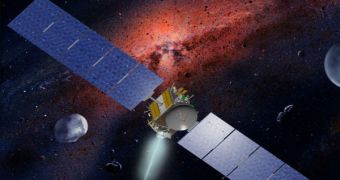Last summer, the Dawn spacecraft, propelled by one of only three ultra-modern ion engines, passed the orbit of Mars, on its way towards the asteroid belt, where its targets, asteroid Vesta and dwarf planet Ceres, resided. In early July, the craft started losing altitude and gradually approaching the Red Planet. Finally, after more than 270 days of non-stop flight, Dawn's ion thruster completely shut down, and the ship accelerated its descent towards Mars. And that's the best news the mission control could have asked for.
The ambitious plan devised at NASA is fairly simple in its conception, but tremendously difficult to complete in real life – astronomers and astrophysicists will try to use Mars' natural slingshot effect to shoot Dawn around the planet, which will basically increase its speed tremendously and will also save extended periods of time. The effect is similar to that the lunar missions had to undergo before departing the orbit of the Earth.
In other words, the ships made use of the speed with which our planet was spinning to gain extra momentum for their own trips. That is to say, they saved time and fuel by doing so.
Now, the Dawn mission control plans to do the same with the probe, which would otherwise have to increase its speed and angle by 5,800 miles per hour (9,330 kilometers per second) and 5 degrees, respectively. By shutting down the ion thruster, the craft will rely solely on Mars' gravitational pull to change both of these factors, after which time it will most likely engage its engine as well.
The plan spared NASA from having to add an extra 230 pounds (104 kilograms) of xenon fuel, which would have otherwise been necessary in order for Dawn to make these changes on its own. “The gravity of Mars will change Dawn's path about the sun, enlarging its elliptical orbit and sending the probe farther from the sun. It will also change Dawn's orbital plane by more than 5 degrees. This is important because Dawn has to maneuver into the same plane in which Vesta orbits the sun,” Dawn project's chief engineer Marc Rayman, from the Jet Propulsion Laboratory in Pasadena, California, says.
He goes on to add that “Not only are our thrusters off and we are dropping in altitude, [but] we are plunging toward Mars. And everybody here on Dawn could not be happier. Without the gravity assist, our mission would not have been affordable, even with the extraordinary capability of the ion propulsion system. That's why we are happy Dawn is now plunging toward Mars.”
“It is fortuitous that we need Mars to get out to Vesta and Ceres. Since there are other spacecraft currently operating at Mars with similar instrumentation, we will be able to check our measurements against their knowledge of Mars, and carry that information farther out into the solar system,” Dawn's deputy principal investigator, JPL scientist Carol Raymond, concludes by saying.

 14 DAY TRIAL //
14 DAY TRIAL //